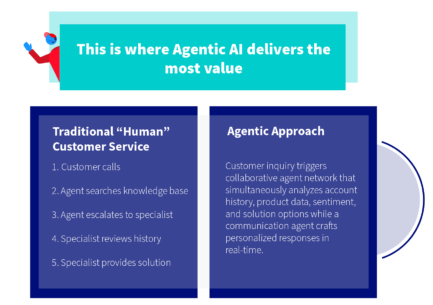A year on from the release of Salesforce Agentforce, CFOs are closely scrutinizing their AI investments. Their CEOs are looking for tangible outcomes from these programs. At a high level, the AI conversation has shifted from what’s possible to what actually delivers business results.
There’s good reason for the scrutiny. Gartner predicts that more than 40% of agentic AI projects will be cancelled by the end of 2027. Research from McKinsey reveals that fewer than 10 percent of AI use cases deployed ever make it past the pilot stage.
For contact center leaders evaluating Agentforce, or looking to unlock the potential value of an existing deployment, the reality on the ground presents both a caution and an opportunity.
On one hand, deploying an agentic AI solution without fundamental preparation risks expensive disappointment. On the other hand, those who make a strategic shift to agentic AI can realize transformative results.
The difference? Avoiding five critical pitfalls that consistently separate successful deployments from underwhelming experiments.
1. Misaligning on What Agentic AI Really is
Hype cycles tend to whip up a flurry of terminology, and the AI era is no different. Agentic AI goes a step beyond generative AI (GenAI). It’s not meant for rule-based automation, general artificial intelligence (GAI), or single-purpose AI models.
Instead, it’s meant for environments in which AI agents work collaboratively on a set of tasks in support of human contact center agent work. The customer-facing AI communication agent is what most contact center professionals think of when they think of agentic AI. For this application to be agentic, however, the AI agent must be capable of dynamic reasoning and autonomous problem-solving.
Then there are agent assist/copilot agents (agentic AI supporting human agents). A copilot provides real-time guidance, suggestions, and automation during customer interactions. Suggested responses may display contextual, real-time recommendations on how the human agent should respond, or what action they can take next.
Finally, you have AI-powered workflow automation agents. Think: automated case routing and escalation across departments; or back-office process automation triggered by customer interactions. Other examples include:
- Cross-system data synchronization and updates
- Automated follow-up workflows and compliance tracking
- Integration between contact center platforms and enterprise systems
A lot becomes possible when you can set broad objectives and allow the AI to reason, adapt, and act autonomously based on real-time context. Agentic AI can decompose complex tasks, autonomously define the shortest path to resolution, and work towards its goal.
For example, an organization may deploy agentic AI to handle major network outages that affect multiple services. This might include:
- A detection agent that monitors network telemetry, identifies anomaly patterns, and handles severity scoring
- A diagnosis agent responsible for correlating logs across OSS/BSS systems and determining root cause hypotheses
- An impact assessment agent that calculates customer/revenue impact and predicts SLA breaches
- A remediation agent that generates repair procedures and coordinates with field teams
- A communication agent that drafts customer notifications and updates stakeholders
This is an ideal application for agentic AI. It’s a goal-oriented, adaptive learning system in which semi-autonomous agents work in parallel using shared context. Is that what your contact center needs? Or is another AI solution (GenAI, for example) more suitable?
Misalignment around agentic AI and what it’s really for tends to result in expensive pilots that solve the wrong problems—automating workflows that should be redesigned, not replicated.
2. Overlooking the Knowledge-Grounding Imperative
Agentic agents are only as good as the knowledge (data) they can access. The organizations finding success with agentic AI—especially within the contact center space—meticulously ground agentic AI agents in verified, continuously updated knowledge bases.
For Salesforce customers, this data grounding challenge becomes particularly acute because many businesses use several software services, which means that data is likely to be stored in disparate sources and formats.
Agentforce agents rely on four core mechanisms to access data:
- Apex classes
- Autolaunched flows
- Prompt templates
- MuleSoft APIs
The challenge for contact centers is that critical customer interaction data often lives outside Salesforce—in Cisco’s Webex Connect (or AI Agent), historical call transcripts, chat logs, and digital channel orchestration systems. Herein lies the importance of knowledge grounding—a true knowledge management system, including:
- Structured data architecture: Customer data, product information, and service history must be unified and accessible. Fragmented systems create fragmented responses—and frustrated customers.
- Dynamic knowledge retrieval: Static FAQs won’t cut it. Agents need real-time access to policy updates, compliance changes, and account-specific information. This means investing in robust API connections and data pipelines before deploying your first agent.
- Context preservation: Unlike traditional IVR systems, customers expect agents to remember previous interactions. This requires persistent memory architecture—not just within a conversation, but across the entire customer journey.
Without proper data and knowledge infrastructure, AI agents may lapse into generic (unhelpful) responses, or outright hallucination. Best to do the hard data architecture work before lackluster agent responses erode customer trust, affect KPIs, or lead to a costly PR debacle.
Data quality and accessibility aren’t just technical prerequisites—they’re the foundation of every successful interaction your AI agents will have. This comprehensive data access transforms Agentforce from a helpful assistant into a truly autonomous problem-solver that can understand, reason, and act with the full context of your customer’s entire experience.
3. Under-Delivering on Security and Compliance
Compliance isn’t just about what AI agents can access, but how they reason about that access. Look to the world of loan approvals for a representative example.
Let’s say a financial services firm deploys an Agentforce agentic AI agent to handle loan approval. Most organizations focus on surface-level compliance. That is:
- Granting access to credit scores, income verification, employment history
- Restricting access to protected characteristics (race, religion, gender)
- Configuring agents to log all data accessed and decisions made
- Limiting agent’s operational scope within pre-defined lending criteria
Fair enough. But what if the AI agent is evaluating loan applications and develops this reasoning pattern:
“Applicants from ZIP codes 10451, 10452, and 10456 have historically higher default rates. While I cannot see race directly, these areas correlate with demographic patterns. I should weigh location more heavily in my risk assessment.”
Here, the agent is essentially redlining. It’s using geographic proxies to make decisions that indirectly discriminate based on protected characteristics. The compliance framework only checked what data the agent accessed (ZIP code = allowed), not how it reasoned about that data.
Successful agentic AI implementations build compliance into three layers:
- Behavioral guardrails: Define explicit boundaries for agent autonomy. Which decisions require human approval? When must disclosures be presented? These rules must be encoded as hard constraints, not suggestions.
- Audit architecture: Every action is tracked and governed but tracking isn’t enough. You need query-able audit logs that can reconstruct any interaction for regulatory review—including the agent’s reasoning process, not just its actions.
- Escalation intelligence: Agents must recognize when they’re approaching the limits of their authority. This requires sophisticated intent detection and clear escalation pathways that preserve context while transitioning to human agents.
4. Missing Process Reinvention Opportunities
Many organizations treat Agentforce as a drop-in replacement for human agents, expecting to automate existing workflows. But human workflows are designed around human limitations (i.e., linear thinking, single-tasking, handoffs between departments, approval chains).
Agentic AI operates differently. It’s designed for parallel processing, in which agents can simultaneously analyze multiple data sources, run scenarios, and coordinate with other agents. It can adjust strategies mid-execution based on new information (real-time adaptation). And it can seamlessly combine insights from disparate systems (cross-domain integration).
The most successful Agentforce implementations leverage this parallel processing capability to transform human agents into strategic orchestrators rather than task executors. While agentic AI handles the simultaneous data analysis, scenario modeling, and cross-system coordination, human agents focus on relationship building, complex problem-solving, and nuanced decision-making that requires empathy and business judgment.

Realizing AI’s full potential requires more than simply inserting AI agents into legacy workflows. It calls for a shift in design mindset—from automating tasks within an existing process to reinventing the entire process.
Old Model
AI agents speed up case creation, autopopulate fields, and suggest faster resolution paths to human
contact center representatives.
New Operational Model
AI agents proactively monitor customer health across all touchpoints and orchestrate interventions before
issues become cases. When a customer’s usage patterns indicate potential churn, AI agents coordinate
across marketing (personalized retention offer), technical support (proactive system optimization), and
account management (relationship check-in) simultaneously.
The goal of an Agentforce deployment should be the creation of entirely new operational models, rather than faster versions of existing ones.
5. Underestimating Hidden Infrastructure Costs
Agentic AI solutions, especially when deployed at scale, can incur recurring costs that exceed the initial investment in development. These include:
- Token/API consumption: Multi-agent conversations generate exponentially more API calls; each agent reasoning step consumes tokens; cross-agent communication and context sharing multiplies usage.
- Memory and context management: Long-term memory for each agent across thousands of customers; vector database storage and retrieval operations; session history and context maintenance; graph database operations for relationship mapping.
- Continuous learning and model fine-tuning: Regular model retraining on new data; A/B testing different agent configurations; performance optimization requiring compute resources; custom model hosting and inference costs.
- Infrastructure scaling requirements: Real-time processing demands expensive compute; high-availability requirements across multiple regions; data pipeline processing for agent training; monitoring and observability tools for complex multi-agent systems.
You can address these cost considerations using one or all of the following strategies:
Interaction Optimization
Not every query needs the full power of an AI agent. Implement intelligent routing that handles simple requests through conventional automation, reserving agents for complex interactions.
Response Caching
Common queries shouldn’t require fresh AI inference every time. Build intelligent caching layers that can serve verified responses without recurring compute costs.
Cost Attribution Models
Without clear visibility into per-interaction costs, optimization is impossible. Implement granular cost tracking from day one, not as an afterthought when the bills arrive.
STAY UP TO DATE
The Path Forward: Strategic Pragmatism
At the current moment, we see Agentforce primarily supporting the human agent experience (agent enablement). At least within the context of the contact center. And though the replacement of human agents by agentic AI may seem inevitable, human-AI collaboration remains a far more likely (and pragmatic) outcome.
The organizations winning with Agentforce aren’t those who deployed fastest—they’re those who prepared most thoroughly by:
- Starting with process, not technology. Broken customer journeys that need reimagining, for example.
- Investing in foundations first. Unified data architecture, strong knowledge management systems, and compliance frameworks.
- Planning for evolution, not revolution. Build flexible architectures that can incorporate new Agentforce capabilities and improvements without requiring a complete overhaul.
This is where bringing Cisco and Salesforce together delivers unique value. While Agentforce excels at agent enablement—giving your human workforce AI superpowers—Cisco’s Webex AI Agent and Webex Connect provide an industry-leading customer-facing intelligence layer. Together, they create a complete solution: AI-enhanced agents handling complex issues with Agentforce support, while routine inquiries flow through Webex’s conversational AI—all orchestrated seamlessly.
You don’t have to choose between human expertise and AI efficiency. The best contact centers will leverage both.





